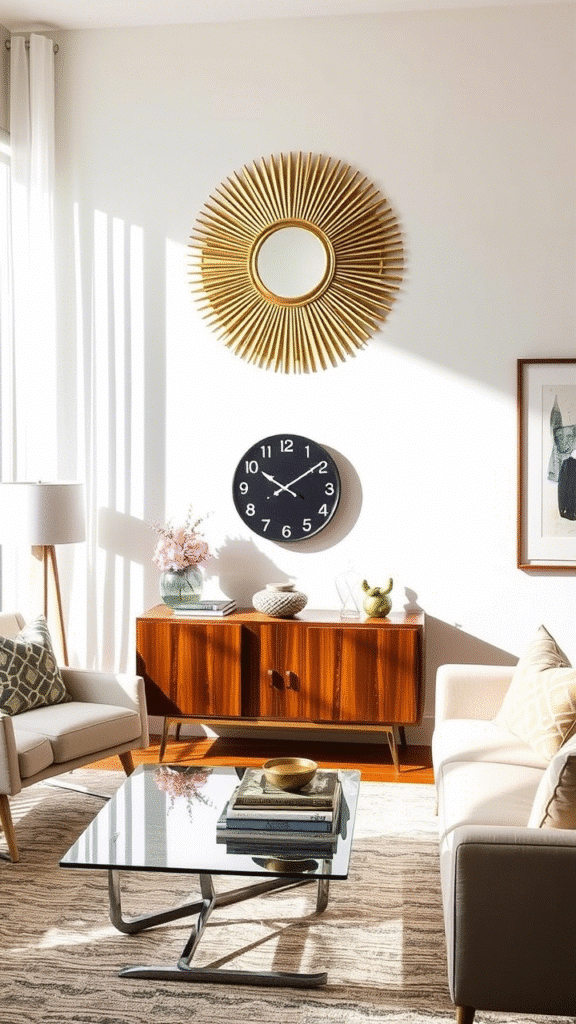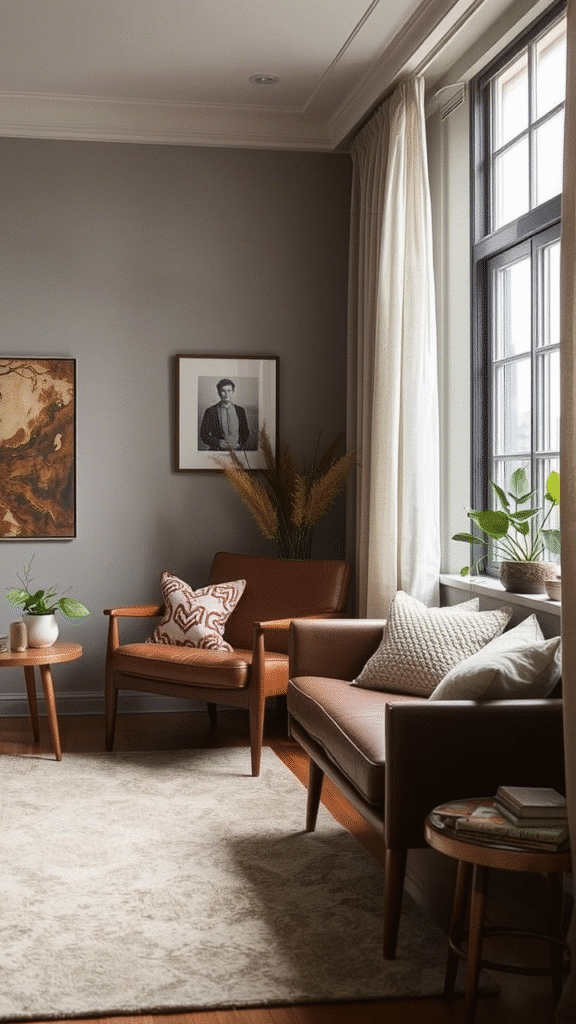Mid-century modern. It rolls off the tongue like a secret password. It’s not just a style—it’s a feeling. A weird, warm mix of nostalgia and sleek coolness that lives somewhere between your grandma’s 1962 credenza and Don Draper’s office chair.
But let’s be real. Pulling off a mid-century modern living room isn’t about chucking random “retro” stuff into a space and praying it works. It’s about intentionality. It’s about knowing which pieces actually matter.
So. What are those pieces? What are the non-negotiables? Let’s go deep and dig into the true heroes of mid-century modern decor for your living room.
The Iconic Low-Slung Sofa
You can’t even whisper the words mid-century modern without someone pointing at a long, low sofa. They’re everywhere. And for a good reason.
Mid-century sofas hug the floor like they’re trying to stay under the radar. Long. Streamlined. Usually perched on skinny tapered legs like they’re too cool for gravity.
Think tweed. Or velvet. Or maybe that buttery tan leather that feels like an old bomber jacket. Earth tones, muted greens, sometimes a rust that feels like it came from a vintage autumn. Not a single tuft too many. No chunky armrests either—nobody’s got time for that.
Bonus points if it’s got a wood frame peeking out somewhere. Like, hey, I’m cozy but I’m still designed.
Teak, Walnut, and More Teak
If you walk into a living room that says mid-century modern and you don’t spot at least one piece of teak or walnut? Something’s off. Like, really off.
Wood is the heart of this style. Not glossy fake stuff. Real grain. Real warmth. That deep, reddish-brown finish that looks like it belongs in a 1965 Scandinavian ski lodge.
Coffee tables. Sideboards. Bookshelves. End tables with weird asymmetrical legs. If it’s made of wood and it has a story, it’s probably welcome here.
What makes teak and walnut so mid-century is how understated they are. They’re not screaming, “look at me.” They just quietly exist, which somehow makes them cooler than loud pieces with shiny metal.
The Starburst Anything

Clocks, mirrors, chandeliers, or even that weird wall art thing you found on Etsy that looks like an exploding sun—if it’s got rays coming out from a center point, it’s mid-century certified.
It’s dramatic, yes. But it’s not gaudy. That’s the magic of a starburst. It can be bold without being tacky. It lives somewhere between geometry and jazz.
You slap a brass starburst mirror above a walnut console table and boom—your living room just went full atomic age.
These things have a pulse. They look like they’re in motion even when they’re not. Like they’re just waiting to spin.
A Statement Chair That Looks Slightly Uncomfortable
Let’s be honest. Some of these chairs are… artistic. They’re the kind of chair that makes you say, “is this meant to be sat in, or just admired from afar?”
And that’s the point.
The Eames lounge chair is obviously the holy grail. It looks like it could host deep conversations about jazz, philosophy, or why martinis should never be shaken. But even if you don’t snag an Eames, you can still find chairs that carry that vibe.
Armless, curvy shapes. Bent plywood. Nubby wool. Something that dips just low enough that your knees feel the air differently. These chairs are architectural. Sculptural. A little weird. In the best way.
You don’t sit in them to watch TV. You sit in them to feel like a grown-up with taste.
Abstract Art That Doesn’t Explain Itself
Mid-century walls aren’t about landscapes or portraits. They’re about suggestions of ideas. Blocks of color. Squiggly lines. Shapes that look like they’re either from outer space or your dreams.
These aren’t “figure out what it means” kinda pieces. These are “just enjoy the vibe” kinda pieces. The less you understand them, the more they work.
And the frames? Thin. Wooden. Or black metal. No big decorative moulding. The art already speaks. The frame just stands there politely.
Gallery walls of mismatched mid-century pieces are welcome. But even just one bold canvas, leaning casually against the wall? That can be enough. That is enough.
Hairpin Legs Everywhere

You see those metal wire-y legs holding up that coffee table? Yup. That’s a hairpin leg. And it’s like the mid-century version of a tattoo—if you’ve got one, you probably want five more.
These skinny metal legs—usually black or brass—support everything from side tables to benches. They’re minimalist. But a little edgy too. Like they belong to furniture that has a double life.
You stick a chunky wooden slab on top of some hairpins and voilà—it’s mid-century without trying too hard.
They give furniture a sort of floating look. Like it’s just lightly touching the ground before it takes off again.
The Sideboard: Storage Meets Swagger
If mid-century modern had a mascot, it’d probably be the sideboard. Or credenza. Or whatever name it’s going by these days.
It’s that long, low wooden cabinet with sliding doors, drawers, and legs that look like they moonlight as ballet dancers. You can hide your clutter inside while your record player or abstract sculpture lives on top like a crown.
Sideboards don’t just hold things. They hold the room together. They say, “this home is intentional, thank you very much.”
And you don’t need to go full vintage, either. Lots of modern brands get the silhouette right. Just keep it simple. Clean lines. Natural wood. No ornate handles.
Lighting That Looks Like Sculpture
Mid-century lighting is like jewelry for your living room. It can be delicate. Or wild. Or just… odd enough to make people look twice.
Arc lamps that swoop like a question mark. Tripod floor lamps with saucer-shaped shades. Table lamps that look like they could double as alien tech. It’s all welcome.
And let’s not forget sputnik chandeliers. They’re like a firework made of brass and glass, permanently frozen in its big bang moment. Hang one over your coffee table and it’s suddenly a museum piece.
Warm bulbs only, please. No cold LEDs. Mid-century light should feel like golden hour—even when it’s midnight.
Rugs That Know How to Be Quiet or Loud
The rug situation is flexible. It can whisper, or it can scream.
You could go for a neutral, tightly-woven rug with a bit of texture. Something soft underfoot but visually chill. A creamy beige. Maybe soft gray.
Or you could go full mod and throw down a geometric pattern with mustard, navy, and olive fighting for dominance. That’s the cool part of mid-century—it embraces both chaos and calm, depending on your mood.
But shag? Eh, be careful. A little goes a long way. A white shag rug can look lush. Or it can look like your dog exploded. Choose wisely.
Plants, But Not a Jungle

Greenery is great. But don’t go overboard.
One fiddle-leaf fig in a matte ceramic pot? Classic. A snake plant in a brass stand? Sophisticated. Succulents on a teak shelf? We’re talkin’ chef’s kiss.
Mid-century modern doesn’t want a rainforest. It wants punctuation. Plants should feel intentional, like commas between thoughts.
No plastic plants either. That’s cheating. If it’s not occasionally threatening to die, it’s not real.
Glass and Metal, But Used Sparingly
You’ll find touches of chrome, steel, and smoked glass in mid-century spaces. But they’re accents, not the main event.
A glass-topped coffee table with metal legs? That works. A metal-framed bookcase with warm wood shelves? Lovely.
But don’t make it a tech showroom. The idea is balance—metal is the sharpness that cuts through the softness of the wood and fabric.
You want your room to hum. Not buzz.
A Bar Cart That Knows What It’s Doing
Is it even a mid-century room if there’s not a bar cart lurking somewhere?
It doesn’t have to be stocked with whiskey and bitters (though that helps). It just needs to look like it might be. Brass frame. Glass shelves. Maybe some vintage glassware. Maybe a weird ice bucket shaped like a pineapple.
Bar carts in mid-century decor are less about drinking and more about dreaming. They harken back to cocktail hours and casual glamor.
Even if you never mix a drink, the cart tells a story. One where you could—if you wanted.
Texture Is Everything

The palette may be muted. The lines may be clean. But texture? Texture is where mid-century modern secretly goes wild.
Think boucle chairs. Leather cushions. Wool rugs. Slubby linen curtains that ripple when the window’s cracked open just a smidge.
You don’t notice texture at first. But your brain loves it. Texture is the quiet background music of a good room. And mid-century modern plays it well.
Personal Touches That Feel Vintage, Not Dusty
Last but definitely not least—your personality. Mid-century doesn’t mean sterile. It doesn’t mean museum-like perfection.
Throw in a ceramic ashtray (even if you don’t smoke). A funky sculpture. An old record sleeve framed on the wall. A worn book with a gorgeous spine. These are the soul bits.
This style is about mixing memory with style. History with modernity. And a little irreverence never hurt nobody.
One weird object that makes no sense but makes you smile? That’s mid-century gold, right there.
Final Thought
Mid-century modern isn’t about copying a catalog. It’s not about strict rules. It’s about creating a space that feels grounded, stylish, and a lil bit nostalgic.
The best living rooms in this style aren’t perfect—they’re lived in. With a sofa that’s seen a few too many naps. A sideboard with a nick on the corner. A chair no one sits in, but everyone talks about.
So take your time. Collect slowly. Layer with intention.
And always, always make room for that one piece that makes absolutely no sense… but somehow ties the whole room together.
FAQs
What’s the difference between mid-century modern and retro?
Mid-century modern focuses on clean lines, organic shapes, and subtle textures from the 1940s–60s. Retro is broader and sometimes louder, often pulling in bolder colors and kitschy details from later decades.
Do I have to use all vintage furniture?
Not at all. You can mix in modern reproductions or inspired pieces. Just stick to the core principles—simplicity, natural materials, and functional beauty.
What color palette works best?
Earth tones are key—olive, mustard, walnut brown, cream, burnt orange. But feel free to add pops of teal, coral, or gold for some extra flair.
Can mid-century modern work in small spaces?
Absolutely. In fact, it’s ideal. Its low-profile furniture and efficient storage pieces are made for small-space living.
How do I make it feel cozy, not cold?
Layer in texture. Use warm lighting. Add personal objects. And don’t be afraid to bend the “rules” a little. Mid-century modern has room for warmth and whimsy.
